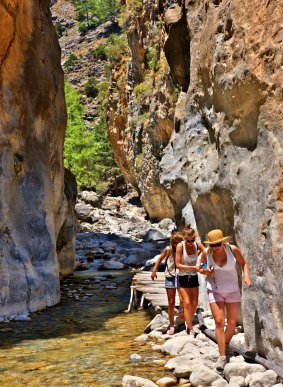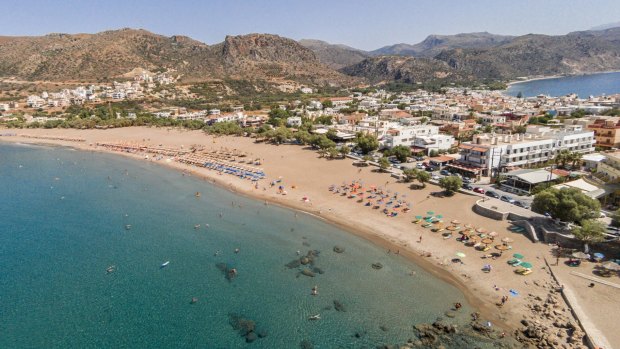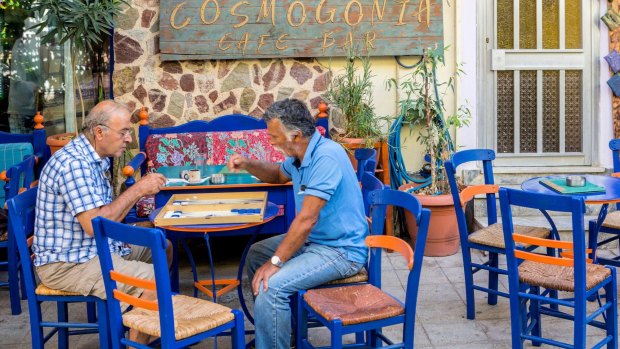This was published 8 years ago
Drive around Crete, Greece: How to escape the crowd on Greece's largest island
Sometimes it pays to do the opposite to what everyone else is doing, Steve Meacham writes.
By Steve Meacham

"Portes", the narrowest passage of Samaria Gorge.Credit: Alamy
"My brother Giorgos and I grew up learning about fish," says Giannis Lougiakis, showing me his kitchen at the oceanfront restaurant the brothers opened in 1988 at one of the most beautiful spots on Crete.
"Our father was a fisherman who taught us the importance of using only the freshest fish," he continues, pointing to the traditional fishing boats in Paleochora's small bay, with its backdrop of mountains.
"But having fresh fish is only part of it. You have to love cooking fish. And as a young man, I discovered cooking fish is what I like to do best in life.

The village of Paleochora in Crete, Greece.Credit: Getty Images
"Now what would you like? The black snapper is very good. Or the red snapper. Or the sea bass..."
Given Giannis' passion, I don't have the heart to tell him that I'd planned to have moussaka for lunch on my one day on Crete.
Instead, I order the grilled black snapper (simple but delicious) with a starter of boureki, the Cretan speciality made of baked zucchini, potatoes and olive oil topped with the soft creamy cheese Greeks call mizithra.

At sunset local men gather in the sleepy taverns in the village of Paleochora.Credit: Alamy
Then I settle back at my outdoor table at Restaurant Caravella, drink a glass of the local tap beer, and ponder my luck at having chosen Paleochora as my destination for the day.
My cruise ship, Azamara Quest, dropped anchor at dawn off Chania Crete's second largest city – a tourist drawcard with its Venetian harbour, narrow streets and famous lighthouse. But, keen to escape the crowds, I pre-booked a cheap hire car on the web.
The welcoming lady in the car rental office suggests I head to Paleochora, explaining the 80-kilometre drive will take around 90 minutes each way, taking me across the mountains to the island's less populated southern shore.
Midway across the range, I stop for a coffee in Kandanos, a mountain town in a gentle valley surrounded by thousands of olive trees. A settlement since antiquity, Kandanos was completely obliterated by the Nazis in 1942 as a reprisal for the resistance activities of the locals.
Near the main church, the Nazis erected a monument to their ruthlessness. The German translates as "Kandanos once existed here". The irony, of course, is that Kandanos has been completely rebuilt, while the Third Reich exists no more.
Forty minutes later, I drive down a winding valley to Paleochora – and am staggered by its breathtaking beauty.
Paleochora's poetic nickname is "The Bride of the Libyan Sea", and it is easy to forget just how far south it is. Here you can catch the twice-weekly ferry to the island of Gavdos, the closest part of Europe to the North African coast.
Hippies made Paleochora a haven during the 1960s, some making their homes in the warren of caves in the surrounding hillsides.
Even today Paleochora retains its alternative, happy-go-lucky personality, though in the summer months its permanent population of 22,000 is swollen by blow-ins from all over Europe. Many are repeat visitors, drawn by the fact Paleochora reminds them "of how Greece used to be when we first came 25 years ago".
Fortunately, I'm here in the autumn when the sun is still sun-bakingly hot but the beaches and streets are uncrowded and the locals have time to chat.
Geographically, Paleochora resembles a giant phallus pointing south towards Africa. At the knob lies Castel Selino, a Venetian fort built in the 13th century but destroyed in the 16th century by the pirate Barbarossa.
The pretty, whitewashed town lies immediately to the north of the fort, squashed on the isthmus between two contrasting beaches. The western beach is sandy, with safe bathing and plenty of sun loungers to rent, while the eastern beach is much rockier with a string of tavernas spread along the esplanade offering views of the mountains and the morning ferry heading to Sougia, Agia Roumeli and Hora Sfakion.
Paleochora is often used as a base for the Samaria Gorge, the 16-kilometre hike that remains one of Crete's most popular active experiences. But the area immediately around Paleochora itself is spectacular hiking country, with several marked trails. Fishing, diving, windsurfing and snorkelling are also available for those feeling energetic.
But most people come to unwind, spending their days discovering the bakeries, the tavernas and the bars. As for nightlife, don't worry too much if you miss Zorba The Greek at the town's open air cinema – it's repeated several times a season.
I wish I had more time to stay here, but as I order the bill, I tell Giannis that I have a cruise ship to catch and want to do a bit of shopping in Chania before we sail.
Giannis delivers the bill with a glass of ouzo on the house. "Paleochora is too good to rush," he says. "Like our fish."
TRIP NOTES
MORE INFORMATION
CRUISING THERE
Azamara Journey has an 11-night Adriatic and Greek Isles voyage departing Venice on May 24, 2016. Fares from $5879 per person, twin share for an interior stateroom. See www.azamaraclubcruises.com/en-au or phone 1800 754 500.
Steve Meacham travelled as guest of Azamara Club Cruises.
Sign up for the Traveller Deals newsletter
Get exclusive travel deals delivered straight to your inbox. Sign up now.